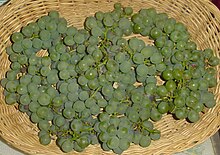
Back Niagara (Rebsorte) German ナイアガラ (ブドウ) Japanese Uva niagara Portuguese Niagara (angy) TLY Ніагара (виноград) Ukrainian
| Niagara | |
|---|---|
| Grape (Vitis) | |
 Niagara grapes | |
| Color of berry skin | Blanc |
| Species | Vitis labrusca |
| Origin | Eastern United States |
| Notable regions | United States |
| VIVC number | 8537 |
Niagara grapes are a variety of the North American grape species Vitis labrusca (botanical family Vitaceae) and are used as table grapes and for wines, as well as jams and juice.[1] Niagara is the leading green grape grown in the United States. A purple variety, known as "pink" niagara (niágara rosada), exists and is the main niagara cultivated in southern Brazil, principally in the states of São Paulo, where the variety first occurred in 1933,[2] and Rio Grande do Sul. The Niagara grape was created in Niagara County, New York, in 1868 when Claudius L. Hoag and Benjamin W. Clark cross-bred Concord grapes with white Cassady grapes. It was first sold commercially in 1882. Niagara grapes are considered to be poor shipping grapes, and so are usually only found near where they are grown. They are most commonly found in the United States in New York, Pennsylvania, New Jersey, Michigan, Washington, and Ohio, and are also grown in Ontario in Canada, as well as in Brazil, and New Zealand. While only rarely available fresh outside these areas, Niagara grapes are well known to most American consumers as the source of most white grape juice.
- ^ Hedrick, Ulysses Prentiss; Booth, Nathaniel Ogden (1908). The grapes of New York. Albany : J.B. Lyon Co., State printers. pp. 359-362.
- ^ "Tradição do cultivo da uva niagara no Estado de São Paulo" (PDF). www.iea.sp.gov.br (in Portuguese). Secretaria de Agricultura e Abastecimento - Instituto de Economia Agrícola (IEA). 27 January 2006.